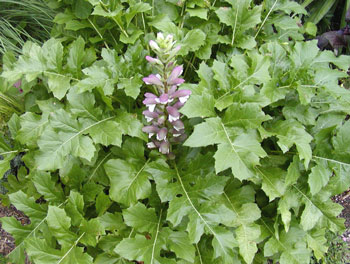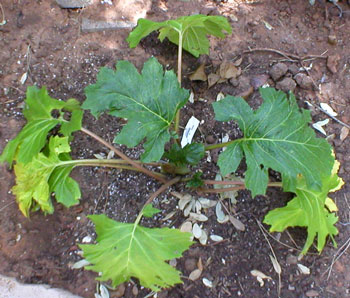
Okay, perhaps she needs "companions."
One of my Marie Paviers is in a bed near the house. She has a deep rosy-red crepe myrtle tree (still young, but full) behind her, and room in all directions for companion plants, though my main concern is in front of her because there's nothing planted there yet.
She's a young thing, not very large. But I'd like advice on either herbs, perinneals or even annuals to plant either behind her (between the rose bush and the crepe myrtle) or in front of her. I want things that make nice visual companion plants, hopefully something that makes a nice "curb" appeal from the street. (I do have three each of purple sage, the herb not the bush; rudbeckia and echinacea in the bed with Marie, but there's room for more!)
Boy, my Marie is beginning to sound a bit loose, isn't she?
And I am pretty sure I've spelled at least three and possibly six words wrong in this post!
If you have lots of room what about Acanthus, Pooks, architectural foliage and purple and white flowers. Well able to hold it's own in the company you mention, and you never know Marie may just be taken with him.
Lavender, Dianthus or Thyme? Give you the added bonus of scent.
Oooo That sounds great Terry - a match made in heaven! I have seen one growing beautifully at a garden in Garland and a friend in E Tex does well with it too, so it should make for a lasting relationship. The others might get lonely, so several acanthus would be dramatic for front of the house. How about carpeting around the gang with a perennial verbena (Blue Princess is my favorite) or if you have full sun and excellent drainage there, phlox subulata would make a great evergreen frame and traffic stopping spring bloom.
Oops, Hi Gail, didn't know you were working on this at the same time too. I like your smell goodum ideas !
Oh, wow -- so many great ideas!
Will acanthus do all right in the sun? I thought they were shade plants.
For a quick fix, I planted a semi-circle of green-and-white Joseph's coat in front of her today. (Hey, at least she has a wardrobe!) It's an annual to fill in this summer. But I'd like to put in some things that will survive the winter.
And what about the size of acanthus? I've never grown them but that sounds like an interesting idea. Will they overpower Marie? She doesn't like being hidden from her adoring public, you know!
I do like the herbal ideas. I have had lavender in that bed before. Lavender doesn't usually thrive for me, for some reason. It might come back after a winter, but just as often doesn't. And never survives longer than a couple of summers. Doesn't stop me from replanting it, though!
My Acanthus does alright in what little sun we get, the leaves reach a height of about 18 inches, the flower spikes are taller but they should not detract. It does, however, require a more moisture retentive soil than Lavender would be happy with. Eryngium would be a better choice if the soil is poor or liable to dry out.
Terry --
I have an acanthus in a pot on my patio, and the more I think of it, the more I'm wanting to plant some in a fairly shady spot in my yard. This is my first year to have any, so I'm actually kind of smitten with him, whether he suits Marie's sunny spot or not!
Here is an acanthus that I raised in a pot from a mailordered bareroot. It's past its bloom and should be beheaded to hopefully make bigger, better, luscious foliage. The site is bright shade and I am tempted to move it to a sunnier site this fall to get it to mature faster. The one I saw in Garland was about 3' wide and was in sun approx from 1:00 to about 3, with shade the rest of the time. Friend in E TX with acanthus has a shade garden - I should ask her if hers gets any sun at all or is only in bright shade. 
Here's the East Texas report!
Acanthus is one of my favorite shade plants & creates architectural interest year round. It is an evergreen & hardy in my zone 8. The first year, I did mulch it very good & protected it in extreme temperatures. I grow one in filtered morning sun & full shade in afternoon. I have another acanthus, which I have been told is a Greek Pattern Plant & I grow it in full shade. This plant looks exactly my acanthus, the only difference being when they bloom those 5 ft. tall purple & white stalks, the Greek Pattern Plants stalks are purple, the acanthus, white. They are either related or one has been misnamed. Can anyone out there solve this mystery for me? Give it plenty of room, they are quite large, taking up about 4 ft. & they do multiply, but not invasive. People ALWAYS ask about this plant!
I went back to the nursery and they said the acanthus they had there gets really big. Won't fit in my small space, darn it!
It's a "bear's" something-or-other. Not a "bear's paw." I'll have to go look and see if there's a tag with the one I put in a pot!
'Bear's Breeches' is the common name for acanthus in general. There are 3 dif kinds - here's the best I can gather from books and surfing, although, as usual, there was often conflict between the sources' data. But this is what I compiled as being the most consistent info.
Acanthus hungaricus prefers a hot, dry, sunny position.
A. spinousus from Turkey, Full sun, hot site, bad soil.
A. mollis from more woodsy shaded sites, deep, moist soil - droops in hot dry weather
It would be interesting to know which of those two you have Judy. I suspect that the Greek leaf name is just one they stuck on to refer to the plants history for its use in Greek architectural design. I think it was on most Corinthian columns (Ionic?) detail and other bits of fancy stone deco. I am hoping mine is the spinousus and will try to dig around for the marker or packing slip tomorrow.
You're absolutely right, Maggie!
From the plant tag:
Acanthus Mollis
Bear's Breech
Grows to 48". Plant 48" apart.
So I could find a different variety to plant in my sunnier spots. (Making note to look for acanthus hungaricus!)
Hi Judy.Just wanted to say that the shade plants I got from you at Maggie's swap were great!I look forward to seeing you at future swaps and those great ferns!
Same here David ...
So many folks have made mention of the wonderful plants they recieved from you Judy! You will have a very disappointed fan club if you can't join us again this fall ;-) And I sure look forward to seeing your pineywoods garden one day.
Here in West Texas - Lubbock- we get very hot and dry, zone 7. A nursery recommended a plant they called "Greek Pattern Plant" acanthus. I planted it in dappled to full shade as the guy recommended, but it is starting to look a bit yellow-ish, and has holes in the leaves. I suspect too much water in poorly draining soil, and bugs, but don't know what kind. Any advice?
I've never had anything chew on my acanthus, but am wondering if it is caterpillar or grasshopper bites. I doubt its getting too much water at this time of year, but drainage is important. The yellowing is prob due to the heat. In hot climes, they tend to wither down,, even disappear and resprout in cool fall temps.
I did a plant-this on the mollis in the paper this year, but haven't put it on the site yet. Should get around to adding more soon.
The above pic on an earlier post is my spinosa.
Below is my . Notice how the spinosa has more spindly leaves.
. Notice how the spinosa has more spindly leaves.
Which does yours more closely resemble?
Well, I messed up the formatting a bit. The above pic is the mollis (it was supposed to come in below the text :-)
Compare its leaves with the spinosa in the older post, way up there
Jo sent me the following pic of her Acanthus, plus some close-ups of the holey concern. The holes are not life threatening. I don't think they are insect damage, but rather a normal part of the declining cycle. 
I believe you have A. mollis.
A young one will have less defined serration in the fronds, plus having been confined in the pot prior to your purchase would have stressed it to go into summer decline earlier than mine in Ft Worth.
I saw a potted mollis at a nursery just last week that looked exactly like yours.
You will be amazed at how well it will do next year - full of foliage and bloom.
Its just a matter of the ol gardening patience paying off in the long run to reap perennial rewards.
Thanks for sending the pics, Jo. I'd love to see it again in maturity.
I am just starting my garden and enjoying every minute of it! I bought what the nursery called an acanthus spinosa, but after reading this it looks more like the a. mollis. I am having problems with it wilting during the day. I have it in part shade, getting about 4hrs of morning sun. Would you suggest moving it, or giving it a little time to get settled? Thanks.
Hi Laura,
That is sadly, the nature of the beast around here.
The best solution is morning sun with afternoon shade. Even then, it will wilt in the afternoons during hot weather. After it blooms (usually in June in North Central Texas), the leaves go into complete decline – such as in the above pic. At that stage, just snip off the ugly leaves and it will sleep through the rest of summer. Come cooler air and (hopefully) autumn rains, it will pop right out again with luscious new foliage until the first freeze.
Because of this cycle, it is best to plant it away from the edge of a border and have something rise in front of it for summer. It is one of those plants that require a bit of juggling to benefit from its best seasons.
One of mine is right up front in the Greek garden and needs to be moved further back for this reason. They can be moved in either their summer or winter dormancy without any problem. Whenever a matured one is moved, some of the root invariably gets left in the ground. Even the tiniest of root pieces will generate new growth – not always a bad thing if you are wanting more acanthus plants.
So, not to worry – don’t get discouraged, because it is not your fault that it is wilting. Learning each new plant’s preferences is the first step to mastering good gardening. The next trial is discovering the most flattering situations for each plant to create the best compositions. The first step is the science; the second is the art. Life-long gardeners never tire of those challenges, which is why a garden is never finished. I wish you a lovely long journey that begins here in your first garden.